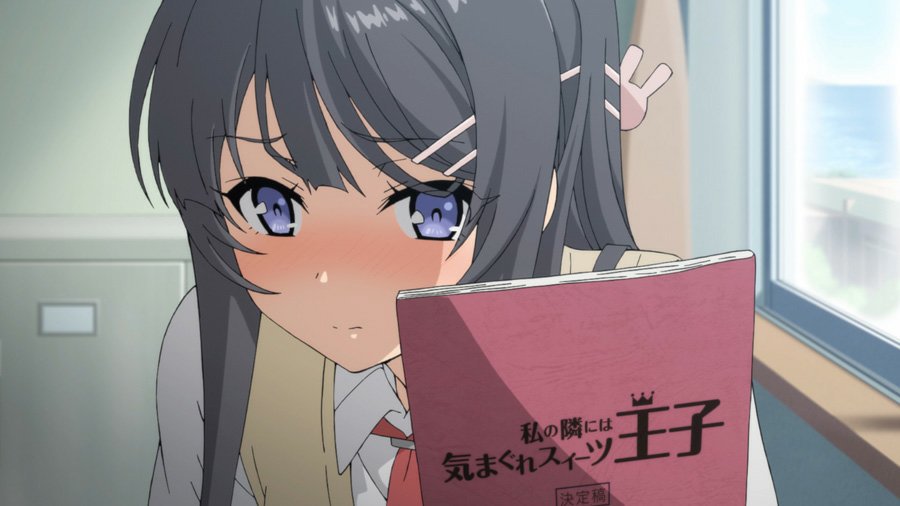
Sakuta is a great character. All too often shonen anime features dense, impulsive characters as I’ve bemoaned for years. Sakuta, finally, offers an emotionally astute and thoughtful alternative. Sakuta doesn’t hesitate to do what is necessary to help people, all the while disparaging himself. He confidently pursues a relationship with Mai. When dealing with the problems of the supporting cast, he plans and executes those plans instead of just impulsively muddling. His level of confidence and his set of priorities label him as a rascal–a norm breaker. But this label isn’t deserved. He doesn’t really act as a rascal, playing pranks and being otherwise disruptive. Rather, he acts as a reasonable, confident guy who has his own issues he wants to keep hidden. Yet he also doesn’t hesitate to act according to the rascal expectations when it benefits someone else.
Sakuta doesn’t steal glances at underwear or do other demeaning things. He makes lewd comments to Mai, but again, never in a way that demeans her. Rather, he uses the comments to express how much he cares for her and finds her sexy. Often he makes the comments whenever Mai is feeling self-conscience. In short, he seeks to build her up instead of reducing her to an object. He wants to make her laugh or give her a chance to lash out with her frustration and anger. Granted, he remains a teen guy and makes mistakes. His bluntness and calculated disregard for what others think of him shows his strength and his weakness. He uses the facade to hide his troubles with his sister and his own emotional problems.
For her part, Mai balances her strength with her desire to connect to someone. She has a similar personality to Sakuta, only she doesn’t buck society as he does. She too is confident and capable. Although as the story progresses, she begins to prioritize her relationship with Sakuta over the social demands on her; she stops hiding their relationship. Mai’s guarded attitude attracted Sakuta in the first place. Well, her bunny girl outfit helped too.
The story opens with Mai taking the role of the “drop-in girl” and turns the old call to adventure, as Joseph Campbell calls it, around. It’s common for a strange girl to appear (literally falling from the sky in many stories) and change the protagonist’s world. Mai does this with her Playboy bunny outfit. However, this call to adventure reverses. Mai is called to adventure by Sakuta. While his life also changes, Mai’s encounter with him starts an adventure that leaves her changed. At the same time, Sakuta gains a pillar of emotional strength and a safe place for his emotional life in her. The encounter repeats with several other characters. These mini adventures progress Mai and Sakuta’s relationship while exploring various other issues people face.
Behind all of this is the plot device called Puberty Syndrome. While the idea is a bit goofy (and explained through quantum physics), it serves well for what it needs to do. It gives the characters a chance to explore the difficulties and insecurities they’ve suppressed. The Syndrome’s lack of realism contrasts against the too-real emotional issues the characters face. It also provides some levity. The Syndrome allows the story to avoid using people as plot devices outside of Mai’s initial appearance. You don’t see a character appear merely to push the story forward. Each character has their own story that weaves into Sakuta’s life in some way. He gains friends. The characters feel rounded, human, because they don’t serve the ends of some overarching plot.
My apologies for remaining vague, by the way. I’m trying to avoid spoilers. Rather, Sakuta helps these characters solve their issues. It’s not like swoops in and saves the day. He assists the characters and provides support for their difficult decisions. He doesn’t solve the problems for them. He can’t. At the same time, he learns a little more about himself with each arc. However, Mai remains his focus and his lifeline in his own concerns.
Rascal impressed me because of the respect it showed its female characters. Sakuta’s sister has a bit of a brother-love-complex that becomes cringy at times, but in light of her emotional issues, it makes sense and has a nuance to it that becomes apparent as the story continues. While Sakuta sometimes makes lewd comments, especially to Mai, he respects the girls. He isn’t trying to catch glimpses like other shonen protagonists. You see little fan service here. Even the infamous bunny outfit has a tastefulness to it compared to the usual anime antics. Usually I have to watch shojo to see this level respect for female characters.
I worried that Rascal was going to fall into the usual problems as it continued, but it never did. I have even considered giving it another watch–which is unusual for me anymore. Most anime stories can easily be thrown away and forgotten. In fact, I have to look through JP to remember what anime I have seen and reviewed. However, Rascal has remained with me since I finished the series. Shows like this remind me how outlandish plots can yield interesting characters. I don’t read books for plots most of the time; I read (and write) for characters.
Rascal Does Not Dream of Bunny Girl Senpai stands as one of the gems of 2018. It is not without its problems, but the dialogue and character interactions feel genuine. Despite the title and poor advertising surrounding it, Rascal is a great watch for those who crave well-written characters.








I love your anime 😍🤩♥️
I’m glad you enjoyed the article!